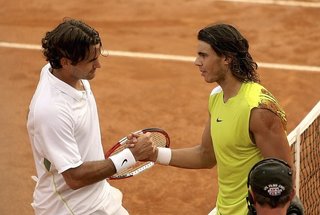Building, building, building...

Fascinating, damn near enrapturing Italian Open final. Nadal wins in five, breaker in the fifth, but Federer made his point, and it has to have gotten into Rafa's head.
I will elucidate:
1. In previous meetings on clay, notably the Monte Carlo final, Nadal has exploited a perceived weakness in Fed's game, the high backhand, by hitting heavily topspun forehands to Fed's "weaker" side. This has allowed Nadal to control the tempo of the matches with his forehand. Federer, however, has now developed a deeper, more powerful, more penetrating topspin backhand reply. It works. He's able to use it to return Nadal's topped crosscourt forehands into Nadal's backhand. Extremely tough to take a crosscourt forehand like Nadal's and redirect it, deep, to his backhand.
2. Federer is taking a page from the Tiger Woods playbook. When Tiger prepares for majors, he "plays" the major venue on regular PGA Tour courses. He works on the shots he will need to win the major. Fed is clearly preparing to play Nadal, in finals, in clay. This is why he's struggling a bit in the early rounds: He's playing Nadal, not his opponent of the moment.
3. So far, at Monte Carlo and in Rome, Fed has inched closer and closer to beating the best clay court player in the world. The Italian could have gone either way. In fact, it all boiled down to a couple of missed Federer forehands in the final set.
4. Tony Roche and Fed are aiming to capture the French Open. Such a victory will not happen overnight. But at least they now know that the tactics they have developed to beat Nadal, the likely opponent, can succeed.
5. Fed is now the second best player in the world on clay, and the first best player in the world on every other surface. This hasn't happened in so long that folks should take note. Let's not forget: Federer won the Australian. Exactly one more forehand winner in Paris, if the Rome final replays, and he's two legs toward the Grand Slam, with his best surfaces—grass and the open hard courts—upcoming. Phenomenal. If he pulls it off, and I believe he will, he will put some real teeth in the notion that he's the best ever.
6. If I'm Nadal, I'm feeling supercool, but I'm also very, very worried about the French. Federer has come up with a brutally effective red clay strategy, created entirely to beat me. This evolution of his game means, in a best-of-five format, lots of quick matches for Fed, over two weeks. I'm going to have to grind it out, however, trading punches with a lot of grinder red-clay specialists. My game simply isn't based on attack they way Fed's natural game is—it's based on trace-like overhitting, to surprisingly accurate effect, at the opportune moment. So if all goes according to the seedings, I'm seeing a fresh Fed at the end of fortnight, while I'm worn down.
7. Federer will win the French, beating Nadal in four. He will then go on (depending on seeding) to beat Andy Roddick again at Wimbledon, and probably either Nadal or Nalbandian (depending on seeing) at the US Open. That's right, I'm calling the Grand Slam. This will immediately change the terms of the debate about who's the Best Ever, putting Fed past Sampras and placiing him in the running against the current Best Ever, Rod Laver.
And what about Nadal? At 19, having surpassed Vilas' clay-court record, he has to be considered an artist of rare ability on the surface. He's not as lovely as Gustavo Kuerten on the dirt, but he is ferocious. However, up to this point, he has relied on his forehand. It's his version of the Andy Roddick problem: He has one huge technical weapon to go along with his fierce competitiveness and will to win. However, to become great on other surfaces, he will need to develop a better serve. And serving is by far the most difficult skill to advance at the pro level. Guga, let's not forget, had a great serve. Borg had a pretty good one. By comparison, Nadal's is weak, especially on second balls.
I'm not skeptical about Nadal's talent. But I do believe that Fed is preparing to peak at this year's French, and at Monte Carlo and in Rome, we are witnessing the groundwork.



0 Comments:
Post a Comment
<< Home